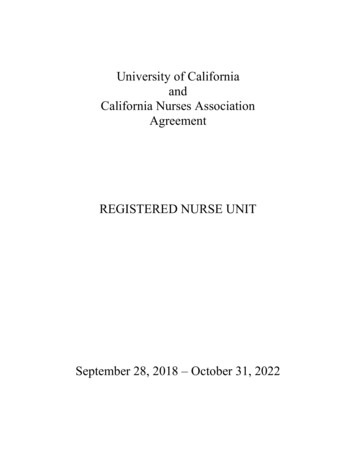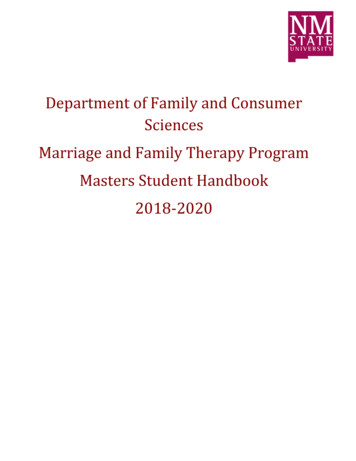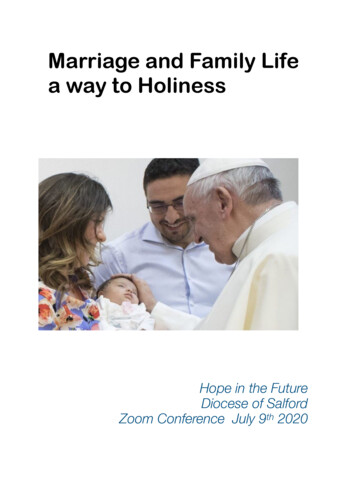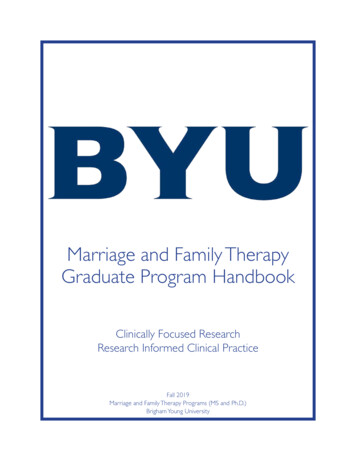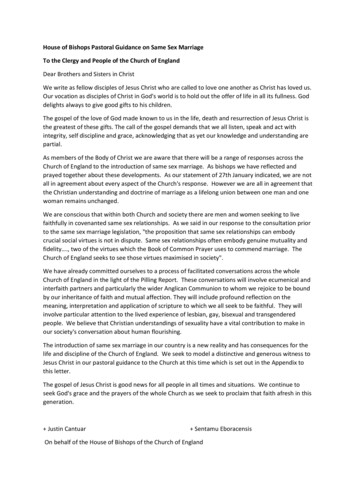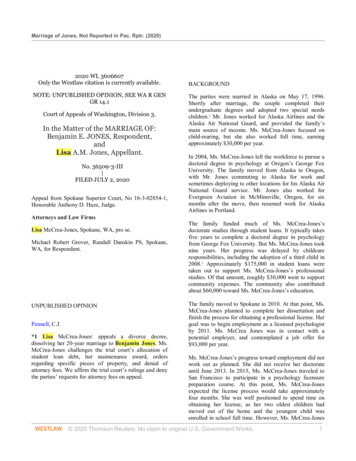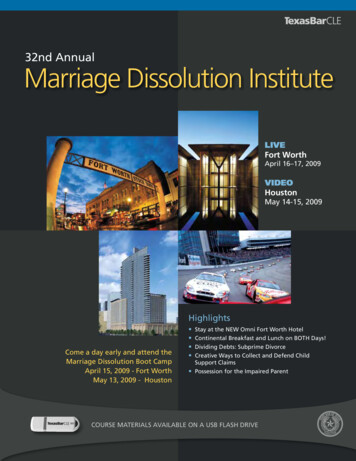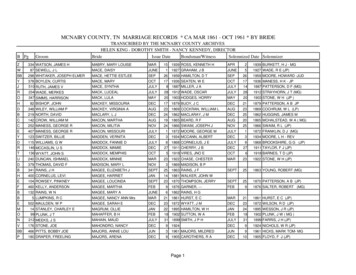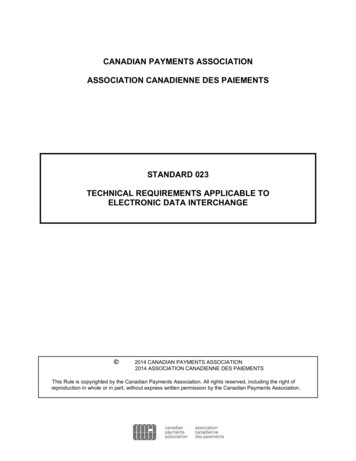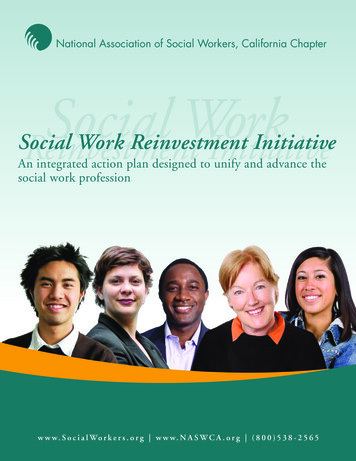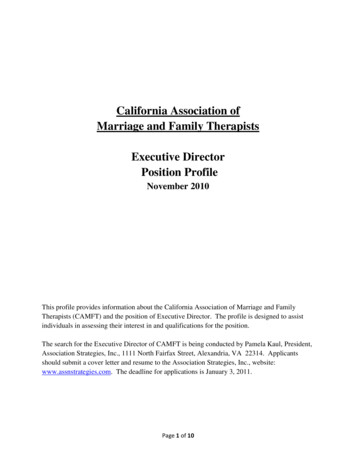
Transcription
California Association ofMarriage and Family TherapistsExecutive DirectorPosition ProfileNovember 2010This profile provides information about the California Association of Marriage and FamilyTherapists (CAMFT) and the position of Executive Director. The profile is designed to assistindividuals in assessing their interest in and qualifications for the position.The search for the Executive Director of CAMFT is being conducted by Pamela Kaul, President,Association Strategies, Inc., 1111 North Fairfax Street, Alexandria, VA 22314. Applicantsshould submit a cover letter and resume to the Association Strategies, Inc., website:www.assnstrategies.com. The deadline for applications is January 3, 2011.Page 1 of 10
Executive Director Position ProfileFor the California Association of Marriage and Family TherapistsProfile MethodologyThe profile for the position of Executive Director of the California Association of Marriage andFamily Therapists (CAMFT) was developed using organizational data, discussions with keystakeholders, and responses to an online survey of current and past committee members, chapterleaders, members of the Board of Directors and Search Committee, staff and representatives ofrelated organizations. The survey was conducted to identify and prioritize the skills, knowledge,experience, qualifications and qualities required and desired in an Executive Director.Information regarding programs and services considered most effective, organizational andcultural factors, and challenges and opportunities for CAMFT was also developed from thesurvey responses.About the OrganizationCAMFT is an independent professional association representing the interests of licensedmarriage and family therapists in the state of California. A 501(c)(6) organization located in SanDiego, it has nearly 30,000 members and is dedicated to advancing the profession as an art and ascience; to maintaining high standards of professional ethics; to upholding the qualifications forthe profession; and to expanding the recognition and awareness of the profession.Mission Statement: The association is dedicated to the advancement of the mental healthprofession by strengthening qualifications and maintaining high standards of professional ethicsand accountability, in order to enhance recognition and utilization of the profession.Vision Statement: Through leadership, education and advocacy, the association and its membersstrive to be exemplary professional resources for mental health professionals and people seekingtheir services.Founded in 1964 as the California State Marriage Counseling Association, the organization’sname was changed to the California Association of Marriage and Family Therapists in 1979.Marriage and family therapists (MFTs) are licensed mental health professionals, in privatepractice or a variety of other settings, who work with individuals, couples, families and groups tocure or relieve mental, emotional and relational concerns of all kinds. They have, at aminimum, acquired two-year masters degrees; have 3,000 hours of supervised experience; andhave passed two rigorous exams. In addition, an associate membership is available to licensedprofessionals or students in a related field.Page 2 of 10
CAMFT has 29 chapters throughout the state to serve the interests of marriage and familytherapists in various geographic areas. The chapters have interests similar to those of CAMFTbut are autonomous entities. The association’s activities revolve around two interrelated themes:(1) the advancement of marriage and family therapy as an art, a science and a mental healthprofession, and (2) the advancement of the common business interests of its members.Structure, Governance and Staff: CAMFT is governed by a 12-member Board of Directors.Under the direction of the Executive Director, the 19-member professional staff administers theprograms, services and activities of the organization within a 4 million operating budget andsupports the work of numerous committees.Key External Interactions: In addition to working closely with the Board of Directors, staff andchapter leaders, the Executive Director represents CAMFT interests through interaction with awide range of related organizations. These include community-based organizations that providethe learning ground for pre-licensed members; public and governmental mental health agencies,departments and institutions that are a part of the mental health system of care; universities andother educational institutions; state and federal legislators; and other related state and federallegislative and/or advocacy organizations. Specifically, these entities include:Access Coalition;American Association of Marriage and Family Therapy (AAMFT);AAMFT-CA;American Counseling Association and its related organizations;Association of Marriage and Family Therapy Regulatory Boards;Board of Behavioral Sciences (BBS), the state regulatory agency responsible forlicensing and examination of MFTs, Licensed Clinical Social Workers, LicensedEducational Psychologists, and professional clinical counselors;California Association of Licensed Professional Clinical Counselors;California Coalition for Mental Health;California Council of Community Mental Health Agencies;California Department of Alcohol and Drug Programs;California Department of Corrections and Rehabilitation;California Department of Insurance;California Department of Managed Health Care;California Department of Mental Health;California Hospital Association;California Mental Health Directors Association;California Mental Health Planning Council;California Psychiatric Association;California Psychological Association;Page 3 of 10
California Society for Clinical Social Work;MFT Consortia of California;Mental Health Association of California;Mental Health Irregulars;Mental Health Services Oversight and Accountability Commission;MSHA MFT State Stipend Program;National Alliance for the Mentally Ill, California;National Association of Social Workers, California Chapter; andOffice of Statewide Health Planning and Development.Programs and ServicesCAMFT’s premier event is the Annual Conference, a four-day event featuring presentations bynationally renowned scholars, practitioners and speakers; workshops; social and networkingevents; and continuing education opportunities. CAMFT also conducts a Fall and WinterWorkshop series each year, three-day events held in Northern and Southern California.In addition, CAMFT offers the following programs, services and benefits to its members:1.2.3.4.5.6.Representation and Advocacy: CAMFT represents and advocates on behalf of itsmembers’ professional goals and interests at both the state and federal levels. It activelymonitors and influences legislation that affects the professional directly and indirectly bysponsoring, supporting or opposing issues before the state legislature and U.S. Congress.Professional Consultations: Members can obtain prompt, accurate and reliable answers tolegal, business, practice and ethical issues.The Therapist: The association’s bi-monthly magazine is dedicated to providinginformation relevant to the profession and serves as a forum for ideas, trends, legislativeupdates and commentary pertinent to marriage and family therapists.Continuing Education: Numerous educational opportunities encourage individuals to stayon the cutting edge of the mental health field and to gain hours of continuing education. Inaddition to such opportunities at the Annual Conference and the Fall and WinterWorkshops, the association provides on-learning activities and numerous self-studyprograms. Through its Continuing Education Registry, CAMFT will assist members bytracking and maintaining records of CE courses in a consistent, professional andunderstandable format. CAMFT also provides members an extensive list of non-CAMFTworkshops, training and courses through its CE Finder.CAMFT Community: Multiple email listserves allow for live discussion forums tailoredto general members, students, educators, chapters, board, committees and other self-forminggroups.CounselingCalifornia.com (previously TherapistFinder): This is a comprehensiveelectronic directory of licensed mental health professionals, a resource that is geared towardPage 4 of 10
consumers seeking professional assistance and allows members to self-market their servicesthroughout California in order to reach potential clients.7. Topical Brochures: CAMFT develops and produces a series of informative, consumeroriented mental health topic brochures, a marketing tool that members can use to educateconsumers and other mental health professionals. The 24 different brochures cover topicssuch as divorce and family issues, recovery, depression, addiction, child and adolescentissues, and self-inflicted harm, among others.8. Scholarships: Various scholarships and grants are offered through CAMFT’s EducationalFoundation each year. Membership in CAMFT is one of the factors considered in thescholarship and grant-selection process.9. Job Board: The Job Board, both on-line and in The Therapist magazine, connects memberswith daily job postings for employment and internships throughout California.10. Mentor Program: The Mentor Program is intended to bring together members who arewilling to serve as mentors with members who are seeking guidance as they pursue thepractice of the profession.11. Credentialing: CAMFT offers a voluntary Certified Supervisor Program, recognizing thattherapists who undertake the responsibility of supervising interns, trainees and associatesshould be prepared with the knowledge, skills and abilities necessary to provide competentsupervision.12. Professional Liability and Malpractice Insurance: The association endorses state-of-theart professional liability coverage for its members at very competitive rates, as well asprovides resources to acquire health, dental, life, disability, long-term care, cancerindemnity, homeowner's or automobile insurance.To learn more about CAMFT, go to www.camft.org.Organizational CultureStakeholders describe the CAMFT staff as one of the most valued and critical components of theorganization’s success. They are described in very positive terms as dedicated, efficient andresponsive to the membership, with a strong sense of customer service. Members place a highvalue on the competence, professionalism and collaborative nature of the staff, noting that theyappear to be a harmonious, cohesive unit with the best interests of the members at heart.The volunteer leadership of the organization is viewed as dedicated, hard-working, forwardthinking and strong advocates on behalf of the association. While many described them asreceptive and transparent, there was a sense among other respondents the association wouldbenefit from greater connection with and engagement between volunteer leaders and members;and that whether due to job and time demands or other forces, at times the volunteer leadershipappears somewhat disconnected from grassroots levels of the organization.Page 5 of 10
The membership in general is described as passionate about the profession and loyal to theorganization and supportive of one another. However, the diversity among members tends, attimes and on certain issues, to be quite challenging as members’ passionate beliefs and themission statement are often interpreted very differently and can lead to disagreement. Membersare extremely appreciative of the many programs, services and resources that the associationprovides, but some express a sense of frustration regarding the difficulty of making a living inthe current economy.Challenges and OpportunitiesCAMFT members and marriage and family therapists are facing an increasingly complex anduncertain healthcare environment. As a group, they are exceptionally complimentary of the whatthey describe as key strengths of the association, among them the legal consultation services; thevalue of The Therapist magazine; the educational programs, especially the Annual Conferenceand Fall/Winter Workshops; the achievements in legislative and policy advocacy efforts;representation of the association to government entities and related organizations; and thecontinuing education opportunities.At the same time, stakeholders note that there is a strong need to raise the profile of theprofession in the public arena and to communicate the value of MFTs as an integral andrespected component of the mental health environment. Others note the significant opportunitythat exists to strengthen and unify the profession through stronger relationships and partnershipswith related organizations.Gaining complete equality with other licensed disciplines in terms of employment access andMedicare reimbursement is an ongoing challenge, as well as an opportunity to demonstrate thevalue of CAMFT to prospective members.The growing needs of chapters for additional support and engagement will require that CAMFTcontinue to explore ways to meet these needs with available resources, thereby maintainingchapters as an integral part of CAMFT. Many note that involvement of chapters in all aspects ofthe association at the local level will only serve to strengthen the state-wide voice of theorganization. In addition, there are opportunities to enhance the diversity and multiculturalaspects of the organization at all levels and on a number of issues, and to develop leadership atthe chapter level for the long-term health and advancement of the organization.In order to maintain the support and involvement of the membership, it is suggested that greaterattention be paid to transparency in governance and to the encouragement of greater participationby members and particularly former leaders.Page 6 of 10
Some stakeholders also suggested that the editing, content and publications standards for TheTherapist magazine could be strengthened and improved by the hiring of a subject expert orclinical journalist in the editor position.Additional challenges and opportunities include:1.Addressing diversity within the membership on such issues as Proposition 8 and socialissues such as gay/lesbian support and involvement;2.Attracting licensed individuals to the profession and membership in the organization;3.The use of technology to attract new members and communicate more effectively withdiverse members in an increasingly “technology-driven world;”4.Addressing potential competition from and possible collaborations with related licensing(e.g., drug and alcohol abuse counselors, licensed social workers, psychologists, etc.); and5.Increasing graduate school enrollment and job availability/higher salaries for MFTs.Executive Director PositionResponsibilities: The Executive Director reports to the Board of Directors and is responsible formanaging the professional staff; directing the organization’s daily operations, programs andactivities; overseeing the development of the annual operating budget and financial resources;and developing and maintaining alliances with key stakeholders and partners. In addition, theExecutive Director will:1.Represent CAMFT’s mission and activities to the public and key stakeholders, as directedby the Board of Directors, and enhance the visibility of the organization and the profession;2.Monitor proposed legislation and public policy that may either positively or negativelyimpact the profession and our clients;3.Hire, manage and develop talented professional staff to implement activities, programs andinitiatives; and communicate effectively with staff to ensure their understanding ofCAMFT’s mission, goals and objectives;4.Maintain and manage the financial integrity of the organization, its funds and assets; andalign the annual operating budget with the Board’s strategic goals and objectives whilemaintaining the highest standards of legal and fiscal responsibility.5.Assist the Board of Directors in determining the long-term strategic direction of CAMFT;and6.Encourage and build effective relationships with related organizations.Page 7 of 10
Education and Experience: The ideal candidate will have a minimum of six to 10 years ofexecutive/management experience in and/or demonstrated knowledge and understanding ofhuman services, behavioral sciences or related organizations. A master’s degree is preferred.Previous experience as a chief executive officer and experience in the association/nonprofitsector is desirable, as is previous experience in legislative and regulatory matters. Anunderstanding of or training in the mental health disciplines and/or certification as a CAE areconsidered a plus.The successful candidate will demonstrate experience in the following areas:1.Effectively serving as the public voice of and spokesperson for an organization;2.Working with legislative processes, advocacy, public policy and regulatory agencies;3.Developing and managing a high-functioning professional staff;4.Developing, supporting and managing a Board of Directors and relationships with otherkey volunteers;5.On-going development and delivery of association services, programs and resources toadvance the profession through effective education and advocacy;6.Developing and implementing strategic plans and initiatives, and identifying andprioritizing short- and long-term organizational goals, needs and resources;7.Expertise in association/nonprofit management;8.Working with and supporting state chapters; and9.Building and maintaining strong alliances and relationships with related organizations.Skills and Abilities: The following skills and abilities are important to the candidate’s success inthe position of Executive Director:1.Strong written and oral communications skills, with the ability to deliver clear and effectivemessages to all stakeholders;2.Visionary leadership, in order to capitalize on opportunities and to identify challenges andthe resources necessary to meet those challenges;3.Ability to build consensus among diverse constituencies and organizations in order tofurther common goals and objectives;4.Ability to build and strengthen the appropriate organizational culture, both internally andexternally;5.Demonstrated financial and business acumen to ensure short- and long-term stability of anorganization’s assets, including development and diversification of sustainable revenuesources; and6.Ability to honor the past without being intimidated by it, and to continue to build for thefuture.Page 8 of 10
Personal Characteristics and Behaviors: The Executive Director will possess the followingpersonal characteristics and behaviors:1.Unquestioned honesty, integrity and ethics;2.Inclusive, collaborative and a team-builder by nature;3.An articulate, skilled communicator; a strong listener who actively invites input from avariety of areas, but who can act decisively and confidently;4.Organized, attentive to operational detail, and responsive to the membership and staff;5.Tactful, diplomatic, personable and accessible; respectful of others’ views and experienceand open to new ideas;6.Effective and results-oriented in overseeing daily operations and implementing Boarddecisions;7.Respectful; mindful of the appropriate role of the Executive Director vis-à-vis the Board ofDirectors and volunteer leaders;8.Inspirational and optimistic demeanor, with the ability to motivate and engage others ineffectively articulating the organization’s vision; and9.Open to working with and learning from others who have skill sets different from his/herown.Measures of SuccessThe Executive Director’s success in the position during the first year will be measured bydemonstrated progress in the following areas:1.Advancement of significant legislative, policy and advocacy issues on behalf of themembership;2.Successful integration into the culture of the association and the quality of relationshipswith volunteer leaders, members and related organizations;2.Stability and morale of the professional staff;3.Quality of communication with and responsiveness to and
art professional liability coverage for its members at very competitive rates, as well as provides resources to acquire health, dental, life, disability, long-term care, cancer indemnity, homeowner's or automobile insurance. To learn more about CAMFT, go to www.camft.org. Organizational Culture
